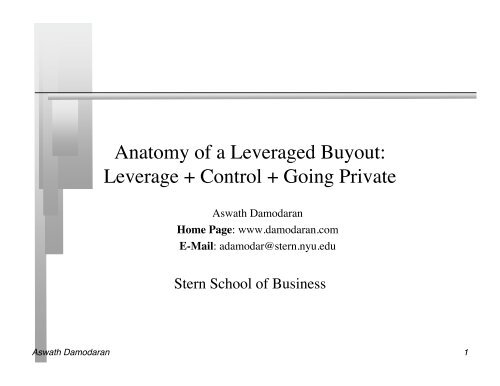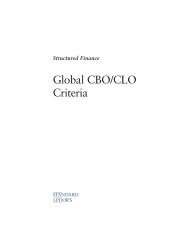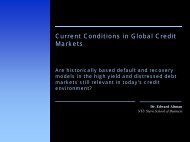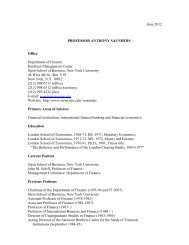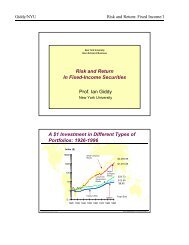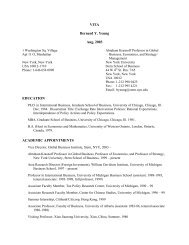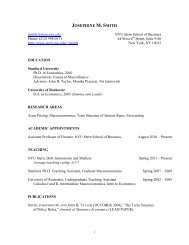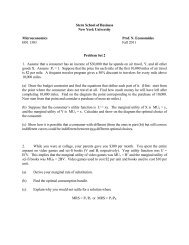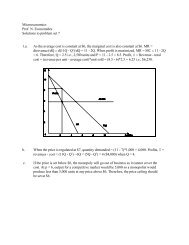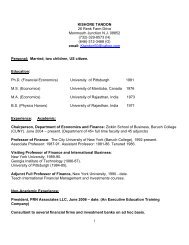Anatomy of a Leveraged Buyout - NYU Stern School of Business
Anatomy of a Leveraged Buyout - NYU Stern School of Business
Anatomy of a Leveraged Buyout - NYU Stern School of Business
Create successful ePaper yourself
Turn your PDF publications into a flip-book with our unique Google optimized e-Paper software.
<strong>Anatomy</strong> <strong>of</strong> a <strong>Leveraged</strong> <strong>Buyout</strong>:<br />
Leverage + Control + Going Private<br />
Aswath Damodaran<br />
Home Page: www.damodaran.com<br />
E-Mail: adamodar@stern.nyu.edu<br />
<strong>Stern</strong> <strong>School</strong> <strong>of</strong> <strong>Business</strong><br />
Aswath Damodaran 1
<strong>Leveraged</strong> <strong>Buyout</strong>s: The Three Possible Components<br />
Increase financial leverage/ debt<br />
Leverage Control<br />
Take the company<br />
private or quasiprivate<br />
<strong>Leveraged</strong> <strong>Buyout</strong><br />
Public/ Private<br />
Change the way<br />
the company is<br />
run (<strong>of</strong>ten with<br />
existing<br />
managers)<br />
Aswath Damodaran 2
One Example: The Harman Deal<br />
Pre-deal<br />
Harman<br />
Debt (mostly<br />
leases)<br />
$274<br />
Publlicly<br />
traded<br />
equity<br />
$ 5.5 billion<br />
KKR & Goldman would<br />
buy out existing equity<br />
investors<br />
Firm will become a<br />
quasi-private<br />
company with 75%<br />
<strong>of</strong> the equity held by<br />
KKR, Goldman and<br />
managers.<br />
Post-deal<br />
Harman<br />
Debt<br />
$ 4 billion<br />
KKR,<br />
Goldman &<br />
Managers<br />
$3 billion<br />
Public<br />
$ 1 billion<br />
Aswath Damodaran 3
Issues in valuing leveraged buyouts<br />
Given that there are three significant changes - an increase in financial<br />
leverage, a change in control/management at the firm and a transition from<br />
public to private status - what are the valuation consequences <strong>of</strong> each one?<br />
Are there correlations across the three? In other words, is the value <strong>of</strong> financial<br />
leverage increased or decreased by the fact that control is changing at the same<br />
time? How does going private alter the way we view the first two?<br />
Given that you are not required to incorporate all three in a transaction, when<br />
does it make sense to do a leveraged buyout? How about just a buyout? How<br />
about just going for a change in control? Just a change in leverage?<br />
Aswath Damodaran 4
I. Value and Leverage<br />
Aswath Damodaran 5
What is debt...<br />
General Rule: Debt generally has the following characteristics:<br />
• Commitment to make fixed payments in the future<br />
• The fixed payments are tax deductible<br />
• Failure to make the payments can lead to either default or loss <strong>of</strong> control <strong>of</strong> the firm<br />
to the party to whom payments are due.<br />
Using this principle, you should include the following in debt<br />
• All interest bearing debt, short as well as long term<br />
• All lease commitments, operating aas well as capital<br />
Aswath Damodaran 6
The fundamental question: Does the mix <strong>of</strong> debt and equity<br />
affect the value <strong>of</strong> a business?<br />
Existing Investments<br />
Generate cashflows today<br />
Includes long lived (fixed) and<br />
short-lived(working<br />
capital) assets<br />
Expected Value that will be<br />
created by future investments<br />
Different Value?<br />
Assets Liabilities<br />
Assets in Place Debt<br />
Growth Assets<br />
Equity<br />
Fixed Claim on cash flows<br />
Little or No role in management<br />
Fixed Maturity<br />
Tax Deductible<br />
Residual Claim on cash flows<br />
Significant Role in management<br />
Perpetual Lives<br />
Different Financing Mix?<br />
Aswath Damodaran 7
A basic proposition about debt and value<br />
For debt to affect value, there have to be tangible benefits and costs associated<br />
with using debt instead <strong>of</strong> equity.<br />
• If the benefits exceed the costs, there will be a gain in value to equity investors<br />
from the use <strong>of</strong> debt.<br />
• If the benefits exactly <strong>of</strong>fset the costs, debt will not affect value<br />
• If the benefits are less than the costs, increasing debt will lower value<br />
Aswath Damodaran 8
1. Tax Benefit:<br />
Debt: The Basic Trade Off<br />
Advantages <strong>of</strong> Borrowing Disadvantages <strong>of</strong> Borrowing<br />
Higher tax rates --> Higher tax benefit<br />
2. Added Discipline:<br />
Greater the separation between managers<br />
and stockholders --> Greater the benefit<br />
1. Bankruptcy Cost:<br />
Higher business risk --> Higher Cost<br />
2. Agency Cost:<br />
Greater the separation between stock-<br />
holders & lenders --> Higher Cost<br />
3. Loss <strong>of</strong> Future Financing Flexibility:<br />
Greater the uncertainty about future<br />
financing needs --> Higher Cost<br />
Aswath Damodaran 9
(a) There are no taxes<br />
A Hypothetical Scenario<br />
(b) Managers have stockholder interests at hear and do what’s best for<br />
stockholders.<br />
(c) No firm ever goes bankrupt<br />
(d) Equity investors are honest with lenders; there is no subterfuge or attempt to<br />
find loopholes in loan agreements<br />
(e) Firms know their future financing needs with certainty<br />
What happens to the trade <strong>of</strong>f between debt and equity? How much should a firm<br />
borrow?<br />
Aswath Damodaran 10
The Miller-Modigliani Theorem<br />
In an environment, where there are no taxes, default risk or agency costs,<br />
capital structure is irrelevant.<br />
The value <strong>of</strong> a firm is independent <strong>of</strong> its debt ratio and the cost <strong>of</strong> capital will<br />
remain unchanged as the leverage changes.<br />
Aswath Damodaran 11
But here is the real world…<br />
In a world with taxes, default risk and agency costs, it is no longer true that<br />
debt and value are unrelated.<br />
In fact, increasing debt can increase the value <strong>of</strong> some firms and reduce the<br />
value <strong>of</strong> others.<br />
For the same firm, debt can increase value up to a point and decrease value<br />
beyond that point.<br />
Aswath Damodaran 12
Tools for assessing the effects <strong>of</strong> debt<br />
The Cost <strong>of</strong> Capital Approach: The optimal debt ratio is the one that<br />
minimizes the cost <strong>of</strong> capital for a firm.<br />
The Enhanced Cost <strong>of</strong> Capital Approach: The optimal debt ratio is the one that<br />
creates a combination <strong>of</strong> cash flows and cost <strong>of</strong> capital that maximizes firm<br />
value.<br />
The Adjusted Present Value Approach: The optimal debt ratio is the one that<br />
maximizes the overall value <strong>of</strong> the firm.<br />
Aswath Damodaran 13
!<br />
a. The Cost <strong>of</strong> Capital Approach<br />
Operating Cash flow is assumed to be unaffected by changing debt ratio<br />
Value <strong>of</strong> Firm =<br />
t="<br />
#<br />
t=1<br />
Free Cash Flow to the Firm t<br />
(1+ Cost <strong>of</strong> Capital) t<br />
If changing the debt ratio changes the cost <strong>of</strong> capital,<br />
the optimal debt ratio is the one that minimizes the<br />
cost <strong>of</strong> capital.<br />
Aswath Damodaran 14
How the debt trade <strong>of</strong>f manifests itself in the cost <strong>of</strong><br />
capital…<br />
Cost <strong>of</strong> capital = Cost <strong>of</strong> Equity (Equity/ (Debt + Equity)) + Pre-tax cost <strong>of</strong> debt (1- tax rate) (Debt/ (Debt + Equity)<br />
As you borrow more, he<br />
equity in the firm will<br />
become more risky as<br />
financial leverage magnifies<br />
business risk. The cost <strong>of</strong><br />
equity will increase<br />
Bankruptcy costs are built into both the<br />
cost <strong>of</strong> equity the pre-tax<br />
cost <strong>of</strong> debt<br />
As you borrow more,<br />
your default risk as a<br />
firm will increase<br />
pushing up your cost<br />
<strong>of</strong> debt.<br />
Tax benefit is<br />
here<br />
At some level <strong>of</strong><br />
borrowing, your tax<br />
benefits may be put<br />
at risk, leading to a<br />
lower tax rate.<br />
Aswath Damodaran 15
The mechanics <strong>of</strong> cost <strong>of</strong> capital computation..<br />
Cost <strong>of</strong> Equity = Rf + Beta (Equity Risk Premium) Pre-tax cost <strong>of</strong> debt = Rf + Defautl sprread<br />
Start with the beta <strong>of</strong> the business (asset or<br />
unlevered beta)<br />
As the firm borrows more, recompute the<br />
debt to equity ratio (D/E) .<br />
Compute a levered beta based on this debt to<br />
equity ratio<br />
Levered beta = Unlevered beta (1 + (1-t) (D./E))<br />
Estimate the cost <strong>of</strong> equity based on the levered<br />
beta<br />
Estimate the interest expense at each debt level<br />
Compute an interest coverage ratio based on expense<br />
Interest coverage ratio = Operating income/ Interest expense<br />
Estimate a synthetic rating at each level <strong>of</strong> debt<br />
Use the rating to come up with a default spread, which when<br />
added to the riskfree rate should yield the pre-tax cost <strong>of</strong> debt<br />
Aswath Damodaran 16
Harman : Working out the mechanics..<br />
Asset or unlevered beta = 1.45 Marginal tax rate = 38%<br />
Debt Ratio Beta Cost <strong>of</strong> Equity Bond Rating Interest rate on debt Tax Rate Cost <strong>of</strong> Debt (after-tax) WACC Firm Value (G)<br />
0% 1.45 10.30% AAA 4.85% 38.00% 3.01% 10.30% $5,660<br />
10% 1.55 10.70% AAA 4.85% 38.00% 3.01% 9.93% $6,063<br />
20% 1.67 11.20% A 5.35% 38.00% 3.32% 9.62% $6,443<br />
30% 1.83 11.84% BB 7.00% 38.00% 4.34% 9.59% $6,485<br />
40% 2.05 12.70% B- 10.50% 38.00% 6.51% 10.22% $5,740<br />
50% 2.39 14.04% CC 14.50% 35.46% 9.36% 11.70% $4,507<br />
60% 3.06 16.74% C 16.50% 25.97% 12.21% 14.02% $3,342<br />
70% 4.08 20.82% C 16.50% 22.26% 12.83% 15.22% $2,938<br />
80% 6.12 28.98% C 16.50% 19.48% 13.29% 16.42% $2,616<br />
90% 12.98 56.40% D 24.50% 11.66% 21.64% 25.12% $1,401<br />
As the cost <strong>of</strong> capital decreases, the firm value increases.<br />
The change in firm value is computed based upon the<br />
change in the cost <strong>of</strong> capital and a perpetual growth rate.<br />
The optimal debt ratio for Harman Audio is about 30% <strong>of</strong><br />
overall firm value. In September 2007, the overall firm value<br />
(debt + equity) was about $ 6 billion, yielding an optimal dollar<br />
debt <strong>of</strong> approximately $1.8 billion.<br />
Aswath Damodaran 17
Harman’s existing debt<br />
The market value <strong>of</strong> interest bearing debt can be estimated:<br />
• In September 2007, Harman had book value <strong>of</strong> debt <strong>of</strong> $76.5 million, interest expenses <strong>of</strong> $9.6<br />
million, a current cost <strong>of</strong> borrowing <strong>of</strong> 4.85% and an weighted average maturity <strong>of</strong> 4 years.<br />
1<br />
Estimated MV <strong>of</strong> Harman Debt = (1"<br />
(1.0485)<br />
9.6<br />
4<br />
#<br />
&<br />
%<br />
( 76.5<br />
%<br />
( + = $97 million<br />
4<br />
% .0485 ( (1.0485)<br />
$<br />
'<br />
Harman has lease commitments stretching into the future<br />
Year Commitment Present Value<br />
1 $43.50 $41.49<br />
2 $40.90 ! $37.20<br />
3 $38.50 $33.40<br />
4 $23.90 $19.78<br />
5 $19.20 $15.15<br />
6-? $31.45 $126.58<br />
Debt Value <strong>of</strong> leases = $273.60<br />
Debt outstanding at Harman =$ 97 + $ 274= $ 371 million<br />
Aswath Damodaran 18
Limitations <strong>of</strong> the Cost <strong>of</strong> Capital approach<br />
It is static: The most critical number in the entire analysis is the operating<br />
income. If that changes, the optimal debt raito will change.<br />
It ignores indirect bankruptcy costs: The operating income is assumed to stay<br />
fixed as the debt ratio and the rating changes.<br />
Beta and Ratings: It is based upon rigid assumptions <strong>of</strong> how market risk and<br />
default risk get borne as the firm borrows more money and the resulting costs.<br />
Aswath Damodaran 19
. Enhanced Cost <strong>of</strong> Capital Approach<br />
Distress cost affected operating income: In the enhanced cost <strong>of</strong> capital<br />
approach, the indirect costs <strong>of</strong> bankruptcy are built into the expected operating<br />
income. As the rating <strong>of</strong> the firm declines, the operating income is adjusted to<br />
reflect the loss in operating income that will occur when customers, suppliers<br />
and investors react.<br />
Dynamic analysis: Rather than look at a single number for operating income,<br />
you can draw from a distribution <strong>of</strong> operating income (thus allowing for<br />
different outcomes).<br />
Aswath Damodaran 20
Estimating the Distress Effect- Harman<br />
Rating Drop in EBITDA<br />
A or higher No effect<br />
A- 2.00%<br />
BBB 5.00%<br />
BB + 10.00%<br />
BB 15.00%<br />
B+ 20.00%<br />
B 20.00%<br />
B- 25.00%<br />
CCC 40.00%<br />
CC 40.00%<br />
C 40.00%<br />
D 50.00%<br />
Indirect bankruptcy costs<br />
manifest themselves when<br />
the rating drops to A and<br />
then start becoming larger<br />
as the rating drops below<br />
investment grade.<br />
Aswath Damodaran 21
The Optimal Debt Ratio with Indirect Bankruptcy Costs<br />
Debt Ratio Beta Cost <strong>of</strong> Equity Bond Rating Interest rate on debt Tax Rate Cost <strong>of</strong> Debt (after-tax) WACC Firm Value (G)<br />
0% 1.45 10.30% AAA 4.85% 38.00% 3.01% 10.30% $5,549<br />
10% 1.55 10.70% AAA 4.85% 38.00% 3.01% 9.93% $6,141<br />
20% 1.67 11.20% A- 5.50% 38.00% 3.41% 9.64% $6,480<br />
30% 1.92 12.17% C 16.50% 24.55% 12.45% 12.26% $1,276<br />
40% 2.33 13.82% D 24.50% 8.94% 22.31% 17.21% $365<br />
50% 2.80 15.68% D 24.50% 7.16% 22.75% 19.21% $308<br />
60% 3.49 18.48% D 24.50% 5.96% 23.04% 21.21% $266<br />
70% 4.66 23.14% D 24.50% 5.11% 23.25% 23.21% $234<br />
80% 6.99 32.46% D 24.50% 4.47% 23.40% 25.21% $209<br />
90% 13.98 60.42% D 24.50% 3.98% 23.53% 27.21% $189<br />
Optimal debt ratio is at 20% ($1.2 billion). Beyond 20%,<br />
the operating income effect will overwhelm any potential<br />
tax benefits.<br />
Aswath Damodaran 22
c. The APV Approach to Optimal Capital Structure<br />
In the adjusted present value approach, the value <strong>of</strong> the firm is written as the<br />
sum <strong>of</strong> the value <strong>of</strong> the firm without debt (the unlevered firm) and the effect <strong>of</strong><br />
debt on firm value<br />
Firm Value = Unlevered Firm Value + (Tax Benefits <strong>of</strong> Debt - Expected<br />
Bankruptcy Cost from the Debt)<br />
The optimal dollar debt level is the one that maximizes firm value<br />
Aswath Damodaran 23
Implementing the APV Approach<br />
Step 1: Estimate the unlevered firm value. This can be done in one <strong>of</strong> two ways:<br />
1. Estimating the unlevered beta, a cost <strong>of</strong> equity based upon the unlevered beta and<br />
valuing the firm using this cost <strong>of</strong> equity (which will also be the cost <strong>of</strong> capital,<br />
with an unlevered firm)<br />
2. Alternatively, Unlevered Firm Value = Current Market Value <strong>of</strong> Firm - Tax<br />
Benefits <strong>of</strong> Debt (Current) + Expected Bankruptcy cost from Debt<br />
Step 2: Estimate the tax benefits at different levels <strong>of</strong> debt. The simplest assumption to<br />
make is that the savings are perpetual, in which case<br />
• Tax benefits = Dollar Debt * Tax Rate<br />
Step 3: Estimate a probability <strong>of</strong> bankruptcy at each debt level, and multiply by the cost<br />
<strong>of</strong> bankruptcy (including both direct and indirect costs) to estimate the expected<br />
bankruptcy cost.<br />
Aswath Damodaran 24
Harman: APV at Debt Ratios<br />
Based upon<br />
synthetic rating<br />
Based on the adjusted present value model, the optimal<br />
dollar debt level at Harman is $1.12 billion. The firm<br />
value is maximized at that point<br />
Bankruptcy cost<br />
estimated to be<br />
25% <strong>of</strong> firm value<br />
Debt Ratio $ Debt Tax Rate Unlevered Firm Value Tax Benefits Bond Rating Probability <strong>of</strong> Default Expected Bankruptcy Value Cost <strong>of</strong> Levered Firm<br />
0% $0 38.00% $5,596 $0 AAA 0.01% $0 $5,596<br />
10% $563 38.00% $5,596 $214 AAA 0.01% $0 $5,810<br />
20% $1,127 38.00% $5,596 $428 A 0.53% $8 $6,016<br />
30% $1,690 38.00% $5,596 $642 B+ 19.28% $301 $5,938<br />
40% $2,253 38.00% $5,596 $856 CC 65.00% $1,049 $5,404<br />
50% $2,817 35.95% $5,596 $1,013 CC 65.00% $1,074 $5,535<br />
60% $3,380 17.73% $5,596 $599 D 100.00% $1,549 $4,647<br />
70% $3,943 15.20% $5,596 $599 D 100.00% $1,549 $4,647<br />
80% $4,506 13.30% $5,596 $599 D 100.00% $1,549 $4,647<br />
90% $5,070 11.82% $5,596 $599 D 100.00% $1,549 $4,647<br />
Aswath Damodaran 25
The “key” determinants <strong>of</strong> debt capacity are tax rates and<br />
cash flows<br />
In all three approaches, the capacity <strong>of</strong> a firm to borrow money is determined<br />
by its cash flows, not its market value or growth prospects.<br />
• The greater the cash flows generated are as a percent <strong>of</strong> enterprise value, the higher<br />
the optimal debt ratio <strong>of</strong> a firm.<br />
• The more stable and predictable these cash flows are, the higher the optimal debt<br />
ratio <strong>of</strong> a firm.<br />
The most significant benefit <strong>of</strong> debt is a tax benefit. Higher tax rates should<br />
lead to higher debt ratios. With a zero tax rate the optimal debt ratio will be<br />
zero.<br />
Implication: Mature or declining firms in businesses that generate high and<br />
predictable cash flows will be the best candidates for financial leverage.<br />
Does Harman pass the test?<br />
Aswath Damodaran 26
The macro environment has a relatively small effect on<br />
optimal debt ratios<br />
Myth 1: Optimal debt ratios will increase as interest rates decline. While it is<br />
true that lower interest rates push down the cost <strong>of</strong> debt, they also push down<br />
the cost <strong>of</strong> equity.<br />
Myth 2: Optimal debt ratios will increase as default spreads decline. Default<br />
spreads have historically declined in buoyant markets, which also push equity<br />
risk premiums down. In other words, both the cost <strong>of</strong> debt and equity become<br />
cheaper.<br />
Aswath Damodaran 27
But bond markets and equity markets sometime deviate…<br />
Aswath Damodaran 28
II. The Value <strong>of</strong> Control<br />
Aswath Damodaran 29
Why control matters…<br />
When valuing a firm, the value <strong>of</strong> control is <strong>of</strong>ten a key factor is<br />
determining value.<br />
For instance,<br />
• In acquisitions, acquirers <strong>of</strong>ten pay a premium for control that can be<br />
substantial<br />
• When buying shares in a publicly traded company, investors <strong>of</strong>ten pay a<br />
premium for voting shares because it gives them a stake in control.\<br />
• In private companies, there is <strong>of</strong>ten a discount atteched to buying minority<br />
stakes in companies because <strong>of</strong> the absence <strong>of</strong> control.<br />
Aswath Damodaran 30
What is the value <strong>of</strong> control?<br />
The value <strong>of</strong> controlling a firm derives from the fact that you believe that you<br />
or someone else would operate the firm differently (and better) from the way it<br />
is operated currently.<br />
The expected value <strong>of</strong> control is the product <strong>of</strong> two variables:<br />
• the change in value from changing the way a firm is operated<br />
• the probability that this change will occur<br />
Aswath Damodaran 31
Value<br />
Firm: Value <strong>of</strong> Firm<br />
Equity: Value <strong>of</strong> Equity<br />
The determinants <strong>of</strong> value<br />
Cash flows<br />
Firm: Pre-debt cash<br />
flow<br />
Equity: After debt<br />
cash flows<br />
DISCOUNTED CASHFLOW VALUATION<br />
Expected Growth<br />
Firm: Growth in<br />
Operating Earnings<br />
Equity: Growth in<br />
Net Income/EPS<br />
CF1 CF2 CF3 CF4 CF5<br />
Length <strong>of</strong> Period <strong>of</strong> High Growth<br />
Discount Rate<br />
Firm:Cost <strong>of</strong> Capital<br />
Equity: Cost <strong>of</strong> Equity<br />
CFn<br />
.........<br />
Firm is in stable growth:<br />
Grows at constant rate<br />
forever<br />
Terminal Value<br />
Aswath Damodaran 32<br />
Forever
Reinvestment Rate<br />
42.00%<br />
Current Cashflow to Firm<br />
EBIT(1-t) : 248<br />
- Nt CpX 67<br />
- Chg WC 37<br />
= FCFF 144<br />
Reinvestment Rate = 104/248=42%<br />
Op. Assets 4,886<br />
+ Cash: 106<br />
- Debt 350<br />
=Equity 4,641<br />
-Options 119<br />
Value/Share $69.32<br />
Cost <strong>of</strong> Equity<br />
10.34%<br />
Riskfree Rate:<br />
Riskfree rate = 4.5%<br />
Cost <strong>of</strong> Debt<br />
(4.5%+%+.35%)(1-.38)<br />
=3.01%<br />
Expected Growth<br />
in EBIT (1-t)<br />
.42*.1456=.0613<br />
6.13%<br />
Discount at Cost <strong>of</strong> Capital (WACC) = 10.34% (.94) + 3.01% (0.06) = 9.91%<br />
+<br />
Beta<br />
1.46<br />
Unlevered Beta for<br />
Sectors: 1.43<br />
Harman: Status Quo<br />
X<br />
Firm!s D/E<br />
Ratio: 6%<br />
Risk Premium<br />
4%<br />
Weights<br />
E = 94%% D = 6%<br />
Mature risk<br />
premium<br />
4%<br />
Return on Capital<br />
14.56%<br />
Stable Growth<br />
g = 4%; Beta = 1.00;<br />
Cost <strong>of</strong> capital = 7.40%<br />
ROC= 12%; Tax rate=38%<br />
Reinvestment Rate=33.33%<br />
Terminal Value5=231(.074-.04) = 6799<br />
Year 1 2 3 4 5<br />
EBIT (1-t) $263 $279 $296 $314 $334<br />
- Reinvestment $111 $117 $125 $132 $140<br />
FCFF $152 $162 $172 $182 $193<br />
Country<br />
Equity Prem<br />
0.%<br />
Term Yr<br />
346.9<br />
115.6<br />
231.3<br />
Aswath Damodaran 33
More efficient<br />
operations and<br />
cost cuttting:<br />
Higher Margins<br />
Divest assets that<br />
have negative EBIT<br />
Reduce tax rate<br />
- moving income to lower tax locales<br />
- transfer pricing<br />
- risk management<br />
Reinvest more in<br />
projects<br />
Increase operating<br />
margins<br />
Increase Cash Flows<br />
Revenues<br />
* Operating Margin<br />
= EBIT<br />
- Tax Rate * EBIT<br />
= EBIT (1-t)<br />
+ Depreciation<br />
- Capital Expenditures<br />
- Chg in Working Capital<br />
= FCFF<br />
Increase Expected Growth<br />
Reinvestment Rate<br />
* Return on Capital<br />
= Expected Growth Rate<br />
Live <strong>of</strong>f past over-<br />
investment<br />
Better inventory<br />
management and<br />
tighter credit policies<br />
Do acquisitions<br />
Increase capital turnover ratio<br />
Firm Value<br />
Reduce the cost <strong>of</strong> capital<br />
Make your<br />
product/service less<br />
discretionary<br />
Reduce beta<br />
Cost <strong>of</strong> Equity * (Equity/Capital) +<br />
Pre-tax Cost <strong>of</strong> Debt (1- tax rate) *<br />
(Debt/Capital)<br />
Match your financing<br />
to your assets:<br />
Reduce your default<br />
risk and cost <strong>of</strong> debt<br />
Increase length <strong>of</strong> growth period<br />
Build on existing<br />
competitive<br />
advantages<br />
Reduce<br />
Operating<br />
leverage<br />
Shift interest<br />
expenses to<br />
higher tax locales<br />
Change financing<br />
mix to reduce<br />
cost <strong>of</strong> capital<br />
Create new<br />
competitive<br />
advantages<br />
Aswath Damodaran 34
Reinvestment Rate<br />
70.00%<br />
Current Cashflow to Firm<br />
EBIT(1-t) : 248<br />
- Nt CpX 67<br />
- Chg WC 37<br />
= FCFF 144<br />
Reinvestment Rate = 104/248=42%<br />
Op. Assets 5588<br />
+ Cash: 106<br />
- Debt 350<br />
=Equity 5,325<br />
-Options 119<br />
Value/Share $80.22<br />
Cost <strong>of</strong> Equity<br />
10.90%<br />
Riskfree Rate:<br />
Riskfree rate = 4.5%<br />
Cost <strong>of</strong> Debt<br />
(4.5%+%+1%)(1-.38)<br />
=3.41%<br />
Expected Growth<br />
in EBIT (1-t)<br />
.70*.15=.105<br />
10.5%<br />
Discount at Cost <strong>of</strong> Capital (WACC) = 10.90% (.80) + 3.41% (0.20) = 9.40%<br />
+<br />
Beta<br />
1.60<br />
Unlevered Beta for<br />
Sectors: 1.43<br />
Harman: Restructured<br />
X<br />
Firm!s D/E<br />
Ratio: 25%<br />
Risk Premium<br />
4%<br />
Weights<br />
E = 80%% D = 20%<br />
Mature risk<br />
premium<br />
4%<br />
Return on Capital<br />
15%<br />
Stable Growth<br />
g = 4%; Beta = 1.00;<br />
Cost <strong>of</strong> capital = 7.48%<br />
ROC= 12%; Tax rate=38%<br />
Reinvestment Rate=33.33%<br />
Terminal Value5=284(.074-.04) = 8155<br />
Year 1 2 3 4 5<br />
EBIT (1-t) $274.7 $303.5 $335.4 $370.6 $409.6<br />
- Reinvestment $192.3 $212.5 $234.8 $259.4 $286.7<br />
FCFF $82.4 $91.1 $100.6 $111.2 $122.9<br />
Country<br />
Equity Prem<br />
0.%<br />
Term Yr<br />
425.9<br />
141.9<br />
284.0<br />
Aswath Damodaran 35
Mechanisms for control<br />
Put pressure on existing managers to change their ways: With activist<br />
investing and proxy contests, you can try to put pressure on existing managers<br />
to change their ways.<br />
• Pluses: Relatively low cost<br />
• Minuses: Managers may be entrenched<br />
Change the managers <strong>of</strong> the company: The board <strong>of</strong> directors, in exceptional<br />
cases, can force out the CEO <strong>of</strong> a company and change top management.<br />
• Pluses: Disruptions minimizes<br />
• Minuses: Board has to be activist and has to pick a good successor<br />
Acquisitions: If internal processes for management change fail, stockholders<br />
have to hope that another firm or outside investor will try to take over the firm<br />
(and change its management).<br />
Aswath Damodaran 36
Implications for the control premium<br />
a. The value <strong>of</strong> control will vary across firms: Since the control premium is the<br />
difference between the status-quo value <strong>of</strong> a firm and its optimal value, it<br />
follows that the premium should be larger for poorly managed firms and<br />
smaller for well managed firms.<br />
b. There can be no rule <strong>of</strong> thumb on control premium: Since control premium will<br />
vary across firms, there can be no simple rule <strong>of</strong> thumb that applies across all<br />
firms. The notion that control is always 20-30% <strong>of</strong> value cannot be right.<br />
c. The control premium should vary depending upon why a firm is performing<br />
badly: The control premium should be higher when a firm is performing badly<br />
because <strong>of</strong> poor management decisions than when a firm’s problems are<br />
caused by external factors over which management has limited or no control.<br />
d. The control premium should be a function <strong>of</strong> the ease <strong>of</strong> making management<br />
changes: It is far easier to change the financing mix <strong>of</strong> an under levered<br />
company than it is to modernize the plant and equipment <strong>of</strong> a manufacturing<br />
company with old and outdated plants.<br />
Aswath Damodaran 37
The perfect “control” target<br />
If control is the motive for an acquisition, the target firm should possess the<br />
following characteristics:<br />
• Its stock has underperformed the sector and the market<br />
• Its margins are lower than the sector with no <strong>of</strong>fsetting benefits (higher turnover<br />
ratios, for instance)<br />
• Its returns on equity and capital lag its costs <strong>of</strong> equity and capital<br />
• The fault lies within the company and can be fixed<br />
Does Harman pass the test?<br />
• Its operating margin is about 11%; the average for the sector is 8%.<br />
• Its return on capital is about 15%; its cost <strong>of</strong> capital is less than 10%;<br />
• Its stock has earned roughly similar returns as the rest <strong>of</strong> the sector<br />
Aswath Damodaran 38
III. The Public/ Private Transition<br />
Aswath Damodaran 39
Why go public?<br />
To raise capital: It is true that private companies have access to new sources <strong>of</strong><br />
capital (private equity, venture capital) that might not have been accessible<br />
decades ago, but it is usually less expensive to raise equity in public markets<br />
than from private hands.<br />
To monetize value: Even if a private firm is valuable, the value is an<br />
abstraction. Being traded puts a “price” on the company, allowing its owners<br />
to get both bragging rights and financial advantages.<br />
To bear risk more efficiently : Much <strong>of</strong> the risk in any business is firm-specific<br />
and diversifiable. Private business owners are <strong>of</strong>ten invested primarily or only<br />
in their businesses. The marginal investors in a public company are more<br />
likely to be diversified and price the business based on the risks that they<br />
perceive.<br />
Aswath Damodaran 40
Perceived Risk: Private versus Public<br />
Private Owner versus Publicly Traded Company Perceptions <strong>of</strong> Risk in an Investment<br />
Private owner <strong>of</strong> business<br />
with 100% <strong>of</strong> your weatlth<br />
invested in the business<br />
Total Beta measures all risk<br />
= Market Beta/ (Portion <strong>of</strong> the<br />
total risk that is market risk)<br />
Is exposed<br />
to all the risk<br />
in the firm<br />
Demands a<br />
cost <strong>of</strong> equity<br />
that reflects this<br />
risk<br />
80 units<br />
<strong>of</strong> firm<br />
specific<br />
risk<br />
20 units<br />
<strong>of</strong> market<br />
risk<br />
Market Beta measures just<br />
market risk<br />
Eliminates firmspecific<br />
risk in<br />
portfolio<br />
Demands a<br />
cost <strong>of</strong> equity<br />
that reflects only<br />
market risk<br />
Publicly traded company<br />
with investors who are diversified<br />
Aswath Damodaran 41
Implications for valuation…<br />
In estimating the cost <strong>of</strong> equity for a publicly traded firm, we use the market<br />
beta (or betas) to come up with the cost <strong>of</strong> equity. Implicitly, we are assuming<br />
that the firm-specific risk will be diversified away and not affect the cost <strong>of</strong><br />
equity.<br />
For a private business owner, this reasoning is flawed. If he or she is<br />
completely invested only in this business, the beta has to reflect total risk and<br />
not just market risk.<br />
Total Beta = Market Beta/ Correlation <strong>of</strong> business with market<br />
Using this approach for Harman, we arrive at the following:<br />
Valued asBeta Cost <strong>of</strong> capital Estimated Value <strong>of</strong> <strong>Business</strong><br />
Public firm 1.46 9.91% $4.9 billion<br />
Private business 2.97 15.6% $2.4 billion<br />
Aswath Damodaran 42
Why go private?<br />
Agency issues: The managers at a publicly traded company may have little<br />
incentive to do what’s best for the company because it is the stockholders’<br />
money that they are playing with.<br />
Disclosure costs: Publicly traded firms have to meet far more disclosure<br />
requirements (FASB, Sarbanes Oxley, SEC) etc. Not only does it cost money<br />
to comply but competitors may be getting valuable information on strategies<br />
and products.<br />
Time horizon: To the extent that publicly traded firms are at the mercy <strong>of</strong> the<br />
short term whims <strong>of</strong> analysts and investors, going private may allow these<br />
firms to make decisions that are best for the long term.<br />
Public pressure: It is easier to bring public pressure on a publicly traded firm<br />
(through regulators, investors etc.) than on a private business.<br />
Aswath Damodaran 43
Minimizing the privatizing cost..<br />
The cost <strong>of</strong> going private (in terms <strong>of</strong> inefficient risk bearing) is far too large<br />
for it to make sense for a publicly traded firm to go private permanently into<br />
the hands <strong>of</strong> a single owner.<br />
The cost <strong>of</strong> bearing risk inefficiently can be reduced by<br />
• Having a portfolio <strong>of</strong> private businesses (The KKR solution); this increases the<br />
correlation with the market and lowers total beta.<br />
• Going private temporarily (with the intent <strong>of</strong> going public again); this will result in<br />
the higher cost <strong>of</strong> capital being applied only for the expected “going private’<br />
period.<br />
Even with these actions, there is a significant residual risk borne by private<br />
equity investors. That risk can be eliminated by the private equity investors<br />
itself going public. (the Blackstone solution)<br />
Aswath Damodaran 44
Good candidates for going private..<br />
Assuming that you are planning to take a company private temporarily and as<br />
part <strong>of</strong> a portfolio <strong>of</strong> such investments, the best candidates for going private<br />
would be companies that have the following characteristics:<br />
• Top managers are not significant stockholders in the firm<br />
• The actions that the firm needs to take to fix its problems are likely to be painful in<br />
the short term. The pain will be reflected in lower earnings and potentially in<br />
actions that create social backlash (lay<strong>of</strong>fs, factory shutdowns…)<br />
• Analysts following the company are not giving it credit for long term actions and<br />
focusing primarily on earnings in the near term.<br />
Does Harman pass the test?<br />
Aswath Damodaran 45
IV. Interactions and Conclusion..<br />
Aswath Damodaran 46
Leverage and Control<br />
The good: A firm that is restructuring to fix its operating problems is likely to<br />
become healthier and be more likely to pay <strong>of</strong>f its debt obligations. In practical<br />
terms, the default risk in this firm decreases because <strong>of</strong> the possibility <strong>of</strong><br />
restructuring.<br />
The bad: Firms that restructure are changing themselves on multiple<br />
dimensions - business mix, cash flows and assets. Lenders who do not monitor<br />
the process may very well find the assets that secure their loans eliminated<br />
from under them and be left holding the bag. The equity investors who control<br />
the busisiness can also direct cashflows into their own pockets (management<br />
fees…)<br />
Implication: Lenders in leveraged buyouts need to take an active role in the<br />
restructuring process and should demand an equity stake in the business.<br />
Aswath Damodaran 47
Control and Going Private<br />
The Good: Since the managers <strong>of</strong> the business are now the owners, they are<br />
likely to become much more aware <strong>of</strong> default risk and distress (since it is their<br />
wealth at play) and be less likely to be overly aggressive risk takers.<br />
The Bad: If things start going bad and the managers decide that they have little<br />
to lose, they will start taking not just more risks but imprudent risks. In effect,<br />
their equity positions have become options and more risk makes them more<br />
valuable.<br />
Implication: Lenders have to step in much sooner and more aggressively, if firms<br />
get into trouble. Letting managers/owners make decisions in their firms can<br />
provide a license to steal. It follows that lending should be restricted to<br />
businesses with transparent and easily understood operations.<br />
Aswath Damodaran 48
Leverage and Going Private<br />
The Good: You could make the owners <strong>of</strong> the company personally liable for<br />
the loans taken by the company. That increases your security and reduces<br />
default costs.<br />
The Bad: Their lawyers are likely to be more creative and inventive than your<br />
lawyers. Assets and cash mysteriously find nooks and crannies to hide…<br />
Implication: Hot deals, where borrowers set the terms, are unlikely to be good<br />
deals for lenders.<br />
Aswath Damodaran 49
The bottom line<br />
Each <strong>of</strong> the three components in an LBO - changing leverage, acquiring<br />
control and going private - has effects on value but the effects can be positive<br />
or negative.<br />
The components are separable. There are some firms that are good candidates<br />
for leveraged recaps (the L in the LBO), others that are ripe for a hostile<br />
acquisition (the B in the LBO) and still others that may benefit from a short<br />
period out <strong>of</strong> the public limelight (the O in the LBO). There may even be a<br />
few that are ready for two out <strong>of</strong> the three components….The list <strong>of</strong> firms that<br />
are right for all three components at the same time is likely to be a very short<br />
one.<br />
Aswath Damodaran 50


